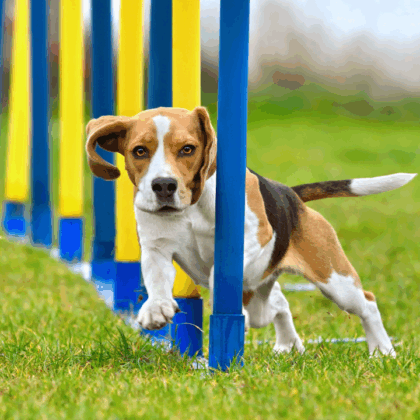The dog who “suddenly” became “stubborn” about jumping. The retriever who “refuses” to pick up the dumbbell from the ground. The agility dog who “won’t” weave poles anymore. The pet dog who slides from a sit to a down.
These scenarios usually trigger the same response: more training, more practice, better treats, or assumptions about the dog’s attitude. But what if these dogs aren’t having a cheese deficiency or simply being difficult—what if they’re being wise?
Dogs lack our human ability to tell us “My shoulder is stiff today” or “That landing yesterday tweaked my back.” or “I played too hard yesterday.” But they can and do make moment-by-moment decisions about what their bodies can handle.
A dog who balks at a jump they’ve cleared hundreds of times before isn’t necessarily losing confidence or being “ring-wise.” They may be protecting joints that are feeling the cumulative stress of repetitive impact. The dog who suddenly would rather not tug might be avoiding the twisting motion that strains a tender spot along their spine.
This isn’t anthropomorphizing—it’s recognizing that dogs are remarkably intelligent about their physical limitations when we allow them to be.
Think about your own behavior when something hurts. If your lower back is bothering you, you automatically modify how you bend, lift, and move. You’re protecting yourself from further discomfort. Dogs do exactly the same thing, but we often interpret their self-protective behaviors as training or even temperament problems.
I once worked with a Belgian Sheepdog who had developed a reputation as a “spook” because he consistently backed away from judges in the conformation ring. His handler was frustrated and embarrassed by his behavior. The dog was fine with familiar people but became evasive whenever strangers tried to examine him.
A functional assessment revealed multiple areas of sensitivity along his back and shoulders—spots where even gentle pressure caused him to flinch or move away. This wasn’t a temperament problem; it was a dog politely trying to avoid being touched in places that hurt. Once his physical issues were addressed through stretching, massage, and chiropractic care, his ring behavior transformed completely.
The wisdom in what we often label as stubbornness becomes clear when we consider the dog’s perspective. They’re making rational decisions based on how their body feels in the moment. A sore shoulder makes reaching down uncomfortable. Tight back muscles make twisting motions unpleasant. Stiff hips make quick direction changes difficult.
Dogs who refuse to perform exercises they previously enjoyed are often the smart ones—they’re saying no to activities that have become uncomfortable rather than pushing through pain that could lead to injury. We need to distinguish between legitimate physical limitations and simple lack of conditioning or motivation.
The dog who stops mid-exercise and looks back at you with soft eyes isn’t necessarily seeking attention or testing boundaries. They may be saying, as clearly as they can, “Something hurts.”

